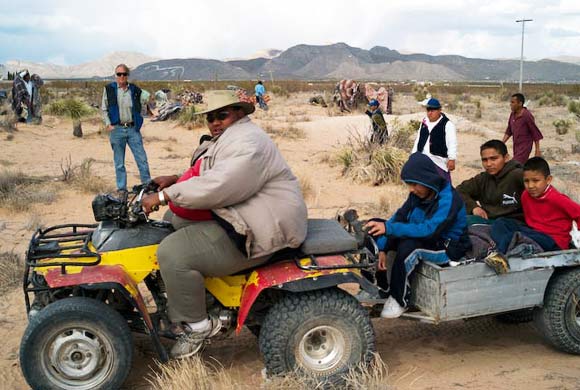Juárez: Killing Is Fun
![]() A Charles Bowden essay, with etched artwork by Alice Leora Briggs: “Juárez: Killing Is Fun.”
A Charles Bowden essay, with etched artwork by Alice Leora Briggs: “Juárez: Killing Is Fun.”
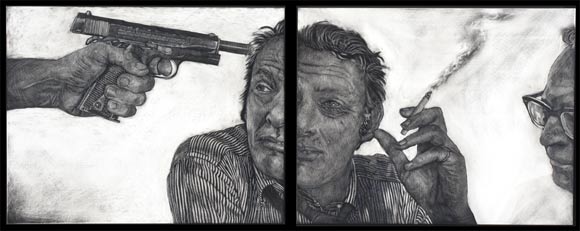
HV photo-audio-essays on our southern neighbors
![]() A Charles Bowden essay, with etched artwork by Alice Leora Briggs: “Juárez: Killing Is Fun.”
A Charles Bowden essay, with etched artwork by Alice Leora Briggs: “Juárez: Killing Is Fun.”

![]() We’ve posted a new photo-essay by Scott Carrier and Julián Cardona, “Ciudad Juárez: Murders, Messages…”
We’ve posted a new photo-essay by Scott Carrier and Julián Cardona, “Ciudad Juárez: Murders, Messages…” 
![]()
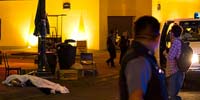 (Part 3 of 3) When people in Juarez, Mexico say ‘drug cartel,’ they mean not only street gangs, but also the government, the military, big business, small business, the upper, middle, and lower classes, the justice system, and the media. Aired on NPR Day to Day; by producer Scott Carrier, “Juarez: Crime More Powerful Than Government” (7:46 mp3):
(Part 3 of 3) When people in Juarez, Mexico say ‘drug cartel,’ they mean not only street gangs, but also the government, the military, big business, small business, the upper, middle, and lower classes, the justice system, and the media. Aired on NPR Day to Day; by producer Scott Carrier, “Juarez: Crime More Powerful Than Government” (7:46 mp3):
This Hearing Voices series was produced by Julian Cardona, Scott Carrier and Lisa Miller; Edited by Deborah George; Translation and Research by Molly Molloy, research librarian at New Mexico State University- Las Cruces; Additional assistance from Erin Almeranti, Elaine Clark.
![]()
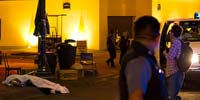 (Part 1 of 3) Murders in Juarez, Mexico now number thousands per year. Photojournalists docuemnt each one. Is it true that “God has a purpose for this city?”. Aired on NPR Day to Day; by producer Scott Carrier, “Juarez: Shooting Crime Scenes” (7:47 mp3):
(Part 1 of 3) Murders in Juarez, Mexico now number thousands per year. Photojournalists docuemnt each one. Is it true that “God has a purpose for this city?”. Aired on NPR Day to Day; by producer Scott Carrier, “Juarez: Shooting Crime Scenes” (7:47 mp3):
This Hearing Voices series was produced by Julian Cardona, Scott Carrier and Lisa Miller; Edited by Deborah George; Translation and Research by Molly Molloy, research librarian at New Mexico State University- Las Cruces; Additional assistance from Erin Almeranti, Elaine Clark.
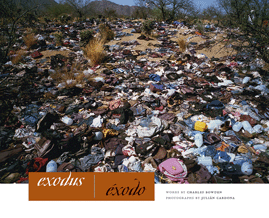 Exodus/Éxodo is a new book (Amazon) with words by Charles Bowden and photographs by Julián Cardona . Excerpt:
Exodus/Éxodo is a new book (Amazon) with words by Charles Bowden and photographs by Julián Cardona . Excerpt:
Consider this: you get up at 5 a.m. You live in a one-room shack and pay $59 a month in rent. Your address is on the outskirts of the world’s second largest megalopolis, México City. You share this shack with your woman, a niece and your child. At 5:30 a.m. you’re on the bus, a ninety-minute ride for $2.45 a day roundtrip. You work in a tortilla shop for $1.64 an hour, eleven hours a day, six days a week. A gallon of milk at the store, the electricity that lights your shack, the fuel running the bus, all these things cost more than in the United States. Basically, everything costs more than in the United States — except labor.
…
Mexican civilization existed before the American people were even a thought. Americans have come to the game very recently, and like so many new arrivals believe they possess all the answers. At the moment, human beings are moving all over the planet to save their hides. Things have been upended, the moon rises at a strange hour, it is blood red, and dripping with hunger.
Scott Carrier and videographer Lisa Miller visit “El Pastor.” José Antonio Galván is a born-again preacher in Juárez, Mexico, who cares for homeless drug-addicted, mentally ill street people with no place to live but El Pastor’s shelter (Albergue Para Discapacitaros Mentales), out in the desert just south of the U.S. border.
“El Pastor” (Part 1 of 2)
“El Pastor” (Part 2 of 2)
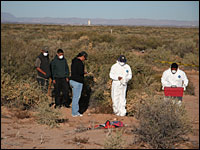 More from Juárez: NPR blog-post and story:
More from Juárez: NPR blog-post and story:
[More from Mexico. This is last story by slain newspaper journalist Armando Rodriguez, of El Diario de Juárez , translated by Molly Molloy, research librarian at New Mexico State University- Las Cruces…]
The man assassinated
Tuesday night in the Diaz Ordaz viaduct
was
a street clown,
according to the state authority.
Nevertheless, this person has not been identified,
but it was reported
that he was between 25 and 30 years old,
1.77 meters tall,
delicate,
light brown complexion,
short black hair.
The victim’s face was painted as a clown,
green with a red nose,
reported the State Prosecutor’s office.
He wore a red polo shirt,
a navy blue sweatshirt, blue jeans,
white underwear,
gray socks labeled USA,
gray and white Converse tennis
and a dark beret.
The body was found in the Diaz Ordaz viaduct,
at Norzagaray Blvd in the colonia Bellavista, on November 11 at 9:40 pm.
The body was found on its side,
with bullet wounds in the right side,
chest and head.
At this time, the motive for the murder is unknown as well as the
identities of the murderers.
[Scott Carrier is working on an HV Hour about the murders in Juárez, Mexico, starting with his NPR series, then moving onto the current much, much worse situation. The following are some emails from Scott…]
Yesterday Armando Rodriguez, the journalist who’d written most of the stories (901) on this year’s executions in Juárez Mexico, was himself executed:
Juarez journalist slain
El Pasa Times staff report 11/13/2008
A Juarez journalist known for his work as a crime reporter for El Diario de Juarez was gunned down Thursday morning in front of his home, the newsapaper’s Web site reported.
Armando Rodriguez was preparing to take his daughter to school in Juarez when a gunman approached his car and fired several shots at point-blank range, according to accounts provided by the newspaper. Rodriguez reportedly died at the scene.
The assailant then fled to a waiting car carrying other men and sped off in an unknown direction.
Rodriguez was the police beat reporter for El Diario de Juarez and had become an expert on the brutal drug cartel violence that has gripped Juarez for the last several years.
“He was a good person and a good reporter,” said KINT-TV (Univision Ch. 26) reporter Pedro Villagrana, who has worked closely with Rodriguez for more than a decade.
Word of Rodriguez’ slaying quickly spread throughout the Juarez and El Paso journalism community. Some members of the Juarez media including his colleagues at El Diario de Juarez gathered at the crime scene to mourn his death, according to the newspaper Web site.
Juárez has always been a violent place. No rule of law. People get killed and nobody is arrested, not even an investigation. What’s new now is the rate of murders. There are more than 100 executions each month in Juárez, 1300 this year alone. Last year there were about 300.
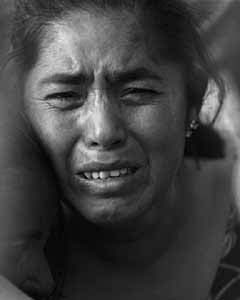
Paula Flores attends the burial of her daughter Sagrario Gonzalez,
a maquiladora worker abducted and killed in April 1998.
(Photo © Julián Cardona)
“Mexico’s Red Days” by Charles Bowden in GQ on the escalating Juárez, Mexico murders:
The killings have the cold feeling of butchery in a slaughterhouse, and they are everywhere: done in broad daylight, on streets, in markets, at homes, and even in Wal-Mart parking lots. Women, children, guilty, innocent—no one is safe.
These are red, endless days.
Author Charles Bowden on the border, © 2008 Julián Cardona:
